IoT protocols and standards: an overview for technical leaders
The Internet of Things (IoT) is reshaping industries and creating smarter, more responsive systems. But seamless connectivity doesn’t happen by chance – behind every connected device lies a network of carefully chosen protocols and standards.
For technical leaders, selecting the right combination is a balancing act between performance, security, scalability, and cost. The challenge? There’s no one-size-fits-all solution. The right choice will depend on your industry’s specific needs and long-term business vision.
Introduction to IoT protocols
IoT protocols act as an invisible force behind the Internet of Things. They enable IoT devices to communicate, exchange data, and trigger actions.
Without them, even the most advanced hardware would be rendered useless, as devices would be unable to communicate with each other.
Why do IoT protocols matter?
IoT protocols are essential for facilitating seamless data transmission among devices, sensors, gateways, servers, and user applications. They ensure interoperability, allowing diverse devices to work together, and support scalability, so networks can expand without performance loss.
Whether you’re optimising a smart home, an industrial plant, or a healthcare system, the right IoT protocols are key to building reliable, future-proof IoT ecosystems.
Check out our IoT development expertise
See what we offerHow to choose the right IoT protocols for your industry?
Each industry has its own operational needs, and the IoT protocol can make or break the deployment. Let’s break down the leading options across key IoT domains and how they measure up.
Smart homes & consumer IoT devices
The following protocols power home automation and consumer devices, ensuring secure data transmission among connected devices within IoT ecosystems.
- Wi-Fi – High data capacity for demanding, data-heavy tasks; energy-intensive.
- BLE (Bluetooth Low Energy) – Low power for battery-powered devices; seamless smartphone integration.
- Zigbee – Open standard for large-scale mesh networking, ideal for smart homes.
- Z-Wave – Closed, operates on less congested frequencies; proprietary alternative with stable connectivity.
Industrial IoT (IIoT)
In industrial settings, reliability and security are key.
- MQTT (Message Queuing Telemetry Transport) – Lightweight, real-time sensor data exchange; requires extra security measures.
- OPC UA (Open Platform Communications Unified Architecture) – Rich data modelling and robust security; higher resource needs.
- Modbus/Modbus TCP-IP – Legacy-friendly and simple; modern variant supports Ethernet connectivity with backward compatibility.
Healthcare & wearable IoT
In wearable medical devices, power efficiency is essential to ensure effective communication between an IoT device and the healthcare system.
- BLE & ANT – Both prioritise low power consumption; BLE has wider adoption, while ANT excels in niche wearable applications.
Agriculture & environmental monitoring
Here, large-scale and low-power connectivity is critical to transmit data efficiently.
- LoRaWAN (Long Range Wide Area Network) – Ideal for long-range, minimal power usage; lower throughput.
- NB-IoT (Narrowband IoT) – Leverages cellular networks for higher data rates; cost and coverage dependent.
How do we work in practice? Here’s a real-world business case
Read the full storyBeyond IoT protocols: key IoT standards
While protocols define how devices communicate, standards ensure that smart devices from different manufacturers work together efficiently.
Choosing the right IoT standards allows you to scale solutions while avoiding vendor lock-in. Here are some of the most impactful ones.
5G
- Ultra-low latency and high capacity for massive IoT deployments; requires significant infrastructure. 5G technology enhances the performance of wireless networks, which are crucial for IoT applications due to their low power consumption and efficient data transmission capabilities.
Interoperability frameworks
- Facilitate communication across multi-vendor ecosystems; success depends on broad collaboration. Extensible messaging, such as the Extensible Messaging and Presence Protocol (XMPP), plays a crucial role in enabling real-time communication and structured data exchanges in these frameworks.
Sparkplug
- Extends MQTT with stateful messaging for improved industrial analytics. Data Distribution Service (DDS) is another protocol that facilitates robust, low-latency communication through a publish-subscribe model, enabling direct peer-to-peer data transmission without relying on a central hub.
EEBUS
- Standardises communication for smart energy management; niche focus on the energy sector.
Matter
- Aims to unify smart home integrations with cross-brand interoperability; ecosystem still growing. Matter’s focus on networking makes it a crucial component in any IoT application, ensuring seamless communication and robust security across devices.
What works best for your industry?
Wi-Fi vs. BLE in smart homes
Wi-Fi provides high data rates, ideal for streaming or large transfers. However, its energy consumption makes it unsuitable for battery-operated sensors.
BLE, in contrast, is optimised for low-energy, intermittent transmissions (short bursts), leveraging widespread smartphone support to boost interoperability in consumer devices.
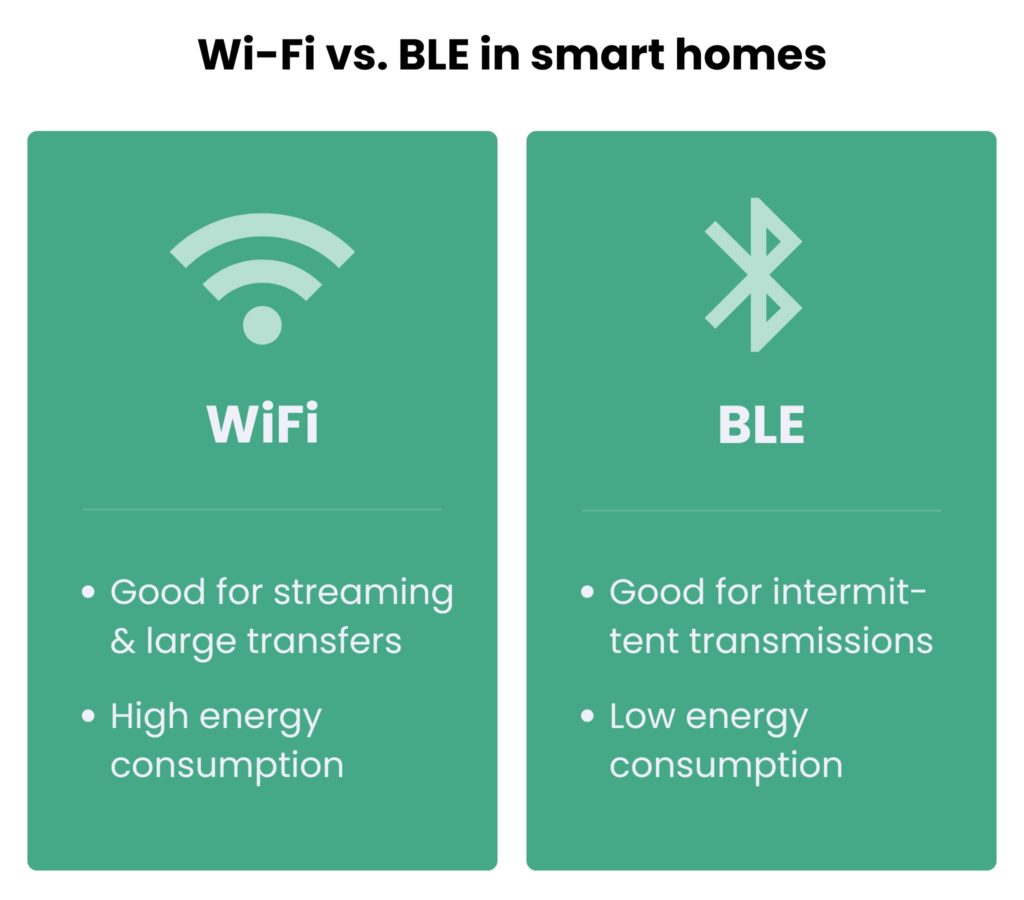
Zigbee vs. Z-Wave for mesh networking
Zigbee’s open standard (especially with Zigbee 3.0) supports diverse vendors and larger mesh networks, aiding scalability despite potential interference in crowded bands.
Earlier versions of Zigbee faced interoperability challenges due to multiple, sometimes incompatible protocol profiles. Zigbee 3.0 unifies these into a single standard, improving compatibility across vendors.
Z-Wave operates on less congested frequencies, offering more stable connectivity even under interference; however, its lower data rate and proprietary nature can limit integration with non-certified devices.
Both protocols are designed for mesh networking topologies where devices communicate directly with each other, relaying messages and extending network coverage. These protocols can be considered a type of presence protocol, managing device presence and availability within the network.
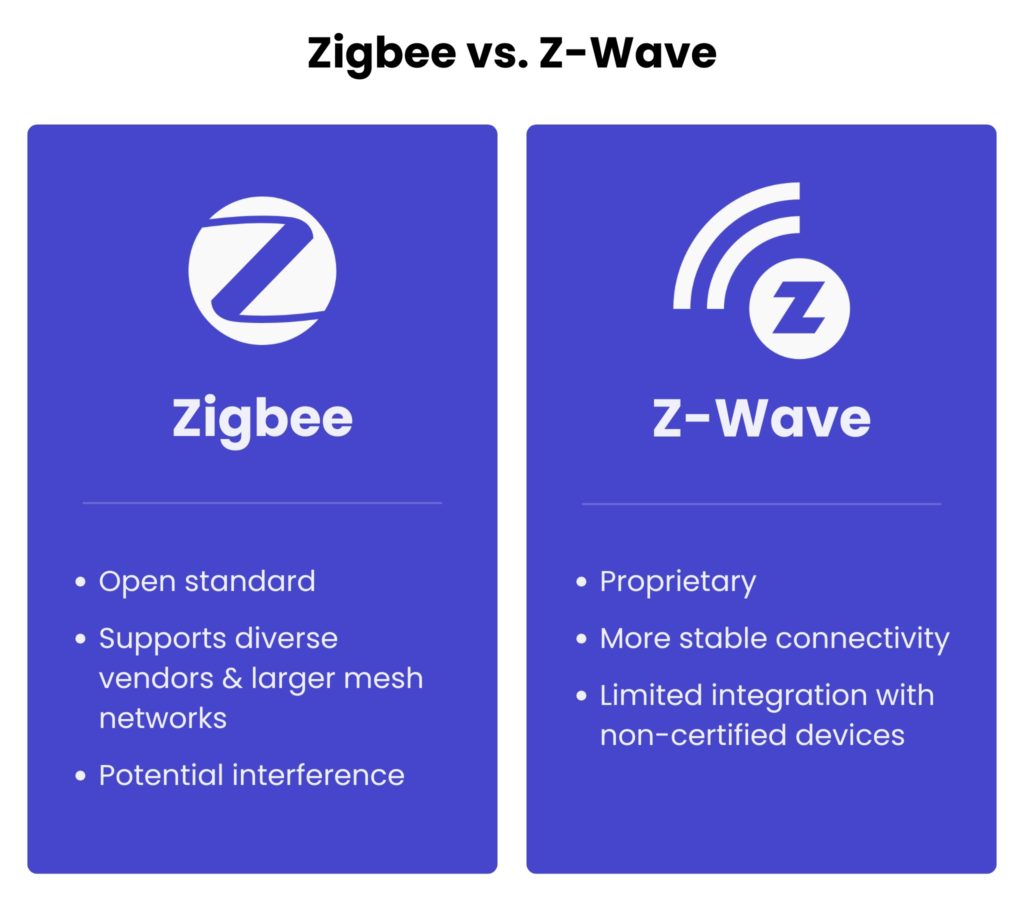
Message Queuing Telemetry Transport (MQTT) vs. OPC UA vs. Modbus in IIoT
MQTT’s lightweight design makes it excellent for real-time messaging in sensor networks but often requires additional security layers.
OPC UA delivers comprehensive security and detailed data modelling, fitting for complex industrial systems despite increased resource demands.
Modbus – and its modern extension, Modbus TCP/IP – provide simplicity and legacy support, though the original lacks inherent security features, making it less attractive for modern deployments.
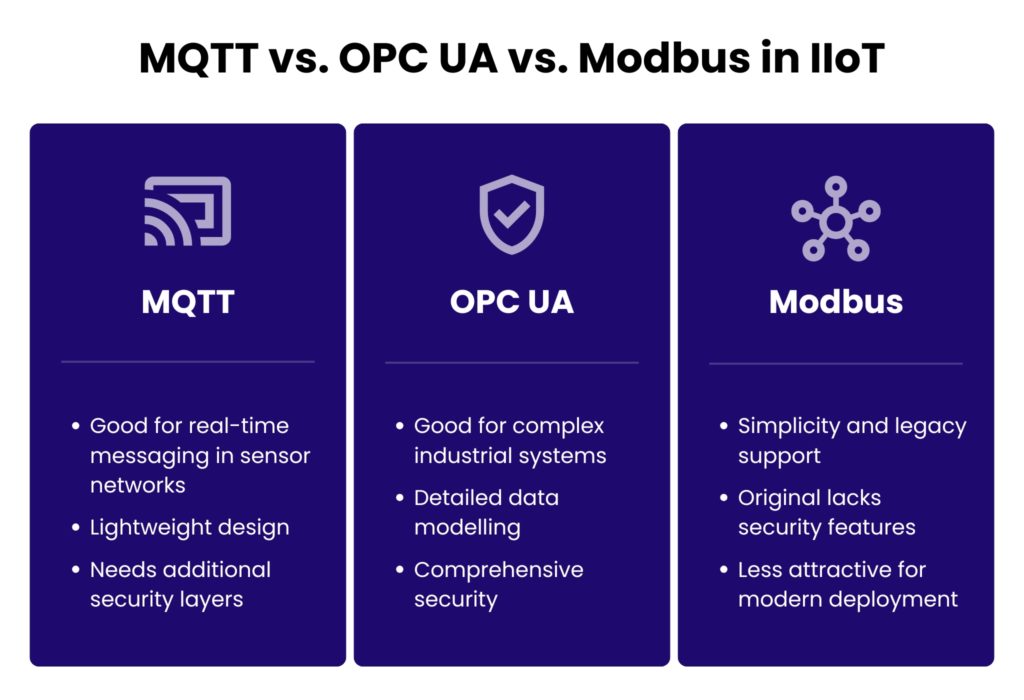
LoRaWAN vs. NB-IoT in agriculture
LoRaWAN is engineered for long-range, low-power connectivity, ideal for expansive remote sensor networks where high throughput isn’t critical.
In contrast, NB-IoT leverages existing cellular infrastructure to deliver better data rates and reliability, though it comes with higher operational costs and is dependent on network coverage quality.
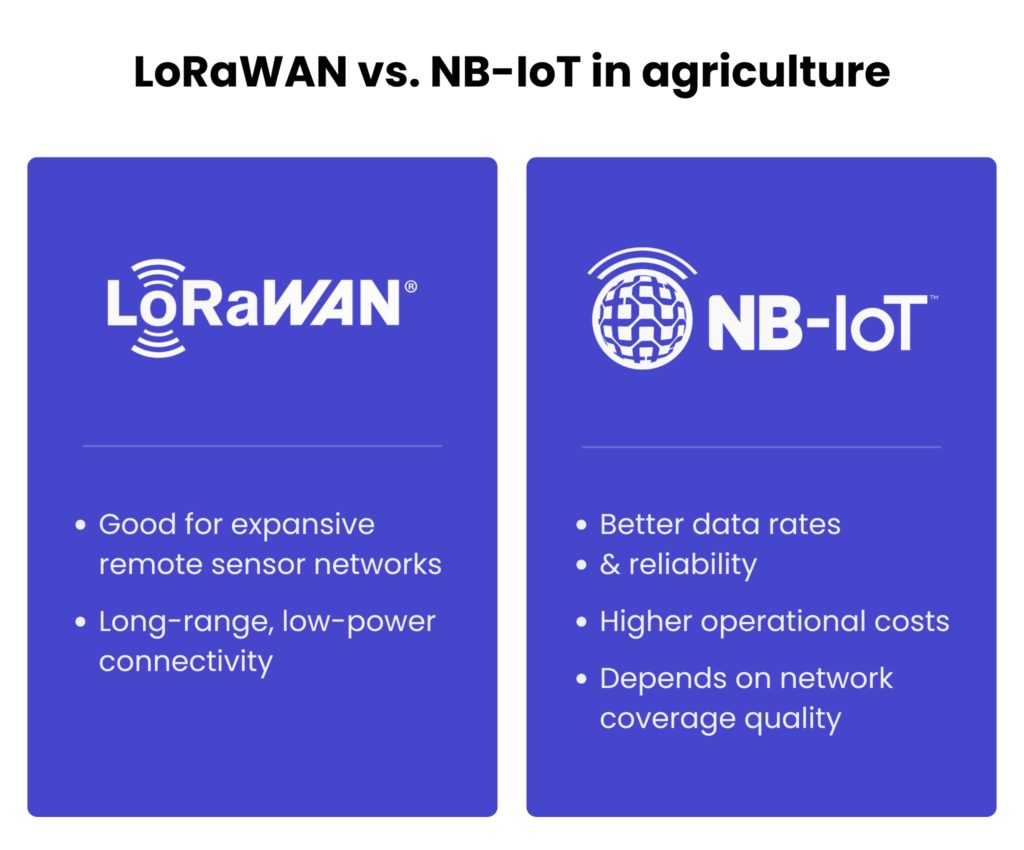
Sparkplug vs. EEBUS vs. Matter
Sparkplug enhances MQTT by adding stateful messaging and edge analytics, making it highly suitable for monitoring and managing industrial edge devices.
EEBUS is tailored for energy management, enabling smart appliances and grids to optimise energy distribution, though its application is specialised.
Matter aims to simplify smart home integrations by establishing a common communication standard, reducing fragmentation and easing development, even though its ecosystem is still maturing.
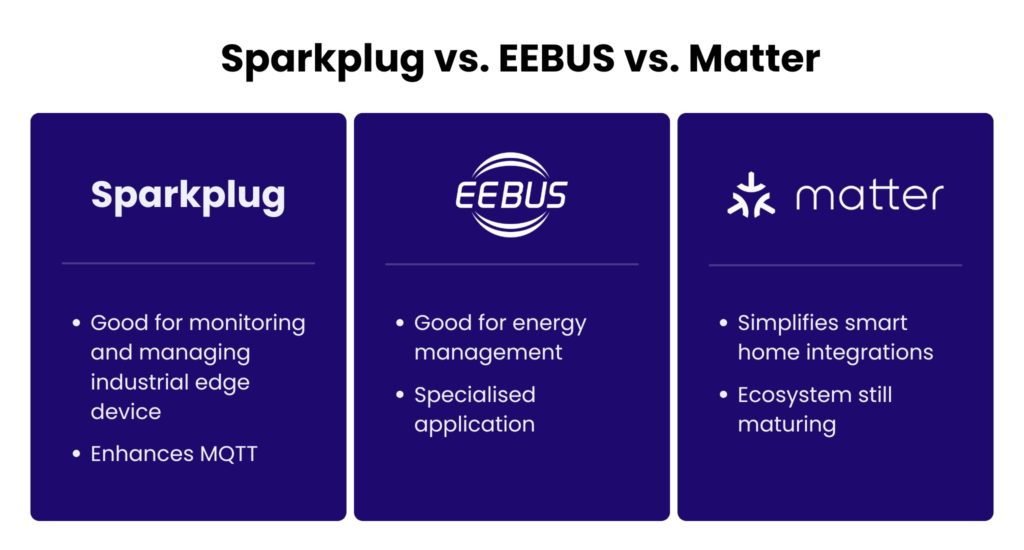
5G vs. interoperability frameworks
5G offers ultra-low latency and high capacity, crucial for real-time industrial automation and smart cities. While it delivers physical connectivity, interoperability frameworks ensure that devices from different manufacturers can communicate seamlessly.
Both complement each other: 5G drives connectivity, and interoperability frameworks unify the ecosystem.
Final thoughts on IoT communication protocols & standards
Choosing the right IoT protocols and standards is both a technical and strategic decision. Whether your focus is on low-energy consumption, seamless interoperability, or industrial security, it’s essential to understand the trade-offs involved.
For CTOs, engineering directors, and software architects, the key to success lies in aligning these decisions with domain-specific requirements and long-term business goals.
By utilising the right mix, you can create scalable and resilient IoT ecosystems.
Navigating IoT protocols and standards can be complex, but you don’t have to do it alone. Let’s discuss how we can help bring your Internet of Things vision to life.
FAQ
Start by evaluating your industry’s specific needs. Consider power consumption, data volume, security, scalability, and device environment. Then match those with protocols suited to those constraints.
Low-power protocols like BLE, LoRaWAN, or Zigbee are ideal for battery-powered devices, especially in wearables, environmental sensors, and smart homes.
Yes, but it requires interoperability frameworks, gateways, or middleware to ensure seamless communication across different protocols and devices.
The wrong protocol can lead to poor performance, increased energy use, limited scalability, integration issues, and security vulnerabilities. This can ultimately drive up costs.
Not always. Open-source protocols (like Zigbee or MQTT) offer flexibility and broad adoption, while proprietary ones (like Z-Wave) may offer more stability or better support, but can lead to vendor lock-in.
About the author
Contact us






